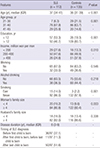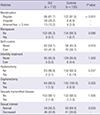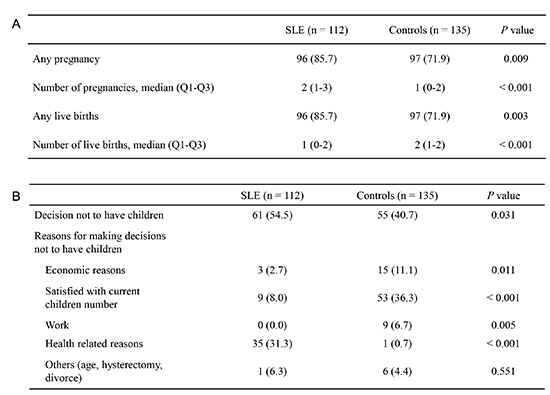1. Clark CA, Spitzer KA, Laskin CA. Decrease in pregnancy loss rates in patients with systemic lupus erythematosus over a 40-year period. J Rheumatol. 2005; 32:1709–1712.
2. Yan Yuen S, Krizova A, Ouimet JM, Pope JE. Pregnancy outcome in systemic lupus erythematosus (SLE) is improving: results from a case control study and literature review. Open Rheumatol J. 2008; 2:89–98.
3. Dhar JP, Essenmacher LM, Ager JW, Sokol RJ. Pregnancy outcomes before and after a diagnosis of systemic lupus erythematosus. Am J Obstet Gynecol. 2005; 193:1444–1455.
4. Clowse ME, Jamison M, Myers E, James AH. A national study of the complications of lupus in pregnancy. Am J Obstet Gynecol. 2008; 199:127.e1–127.e6.
5. Smyth A, Oliveira GH, Lahr BD, Bailey KR, Norby SM, Garovic VD. A systematic review and meta-analysis of pregnancy outcomes in patients with systemic lupus erythematosus and lupus nephritis. Clin J Am Soc Nephrol. 2010; 5:2060–2068.
6. Park EJ, Jung H, Hwang J, Kim H, Lee J, Ahn JK, Cha HS, Koh EM. Pregnancy outcomes in patients with systemic lupus erythematosus: a retrospective review of 62 pregnancies at a single tertiary center in South Korea. Int J Rheum Dis. 2014; 17:887–897.
7. Clowse ME, Magder LS, Witter F, Petri M. The impact of increased lupus activity on obstetric outcomes. Arthritis Rheum. 2005; 52:514–521.
8. Saavedra MA, Cruz-Reyes C, Vera-Lastra O, Romero GT, Cruz-Cruz P, Arias-Flores R, Jara LJ. Impact of previous lupus nephritis on maternal and fetal outcomes during pregnancy. Clin Rheumatol. 2012; 31:813–819.
9. Østensen M, Khamashta M, Lockshin M, Parke A, Brucato A, Carp H, Doria A, Rai R, Meroni P, Cetin I, et al. Anti-inflammatory and immunosuppressive drugs and reproduction. Arthritis Res Ther. 2006; 8:209–227.
10. Koh JH, Ko HS, Lee J, Jung SM, Kwok SK, Ju JH, Park SH. Pregnancy and patients with preexisting lupus nephritis: 15 years of experience at a single center in Korea. Lupus. 2015; 24:764–772.
11. Ko HS, Ahn HY, Jang DG, Choi SK, Park YG, Park IY, Lee G, Park SH, Shin JC. Pregnancy outcomes and appropriate timing of pregnancy in 183 pregnancies in Korean patients with SLE. Int J Med Sci. 2011; 8:577–583.
12. Clowse ME, Chakravarty E, Costenbader KH, Chambers C, Michaud K. Effects of infertility, pregnancy loss, and patient concerns on family size of women with rheumatoid arthritis and systemic lupus erythematosus. Arthritis Care Res (Hoboken). 2012; 64:668–674.
13. Benzies K, Tough S, Tofflemire K, Frick C, Faber A, Newburn-Cook C. Factors influencing women’s decisions about timing of motherhood. J Obstet Gynecol Neonatal Nurs. 2006; 35:625–633.
14. Hochberg MC. Updating the American College of Rheumatology revised criteria for the classification of systemic lupus erythematosus. Arthritis Rheum. 1997; 40:1725.
15. Skomsvoll JF, Ostensen M, Baste V, Irgens LM. Number of births, interpregnancy interval, and subsequent pregnancy rate after a diagnosis of inflammatory rheumatic disease in Norwegian women. J Rheumatol. 2001; 28:2310–2314.
16. Vinet E, Labrecque J, Pineau CA, Clarke AE, St-Pierre Y, Platt R, Bernatsky S. A population-based assessment of live births in women with systemic lupus erythematosus. Ann Rheum Dis. 2012; 71:557–559.
17. Vinet E, Clarke AE, Gordon C, Urowitz MB, Hanly JG, Pineau CA, Isenberg D, Rahman A, Wallace D, Alarcón GS, et al. Decreased live births in women with systemic lupus erythematosus. Arthritis Care Res (Hoboken). 2011; 63:1068–1072.
18. Hardy CJ, Palmer BP, Morton SJ, Muir KR, Powell RJ. Pregnancy outcome and family size in systemic lupus erythematosus: a case-control study. Rheumatology (Oxford). 1999; 38:559–563.
19. Vinet E, Pineau C, Gordon C, Clarke AE, Bernatsky S. Systemic lupus erythematosus in women: impact on family size. Arthritis Rheum. 2008; 59:1656–1660.
20. Ateka-Barrutia O, Khamashta MA. The challenge of pregnancy for patients with SLE. Lupus. 2013; 22:1295–1308.
21. Petri M, Allbritton J. Fetal outcome of lupus pregnancy: a retrospective case-control study of the Hopkins Lupus Cohort. J Rheumatol. 1993; 20:650–656.
22. [accessed on
23. Pasoto SG, Mendonça BB, Bonfá E. Menstrual disturbances in patients with systemic lupus erythematosus without alkylating therapy: clinical, hormonal and therapeutic associations. Lupus. 2002; 11:175–180.
24. Østensen M. New insights into sexual functioning and fertility in rheumatic diseases. Best Pract Res Clin Rheumatol. 2004; 18:219–232.
25. Curry SL, Levine SB, Corty E, Jones PK, Kurit DM. The impact of systemic lupus erythematosus on women’s sexual functioning. J Rheumatol. 1994; 21:2254–2260.
26. Yazdany J, Trupin L, Kaiser R, Schmajuk G, Gillis JZ, Chakravarty E, Schwarz EB. Contraceptive counseling and use among women with systemic lupus erythematosus: a gap in health care quality? Arthritis Care Res (Hoboken). 2011; 63:358–365.
27. Al Arfaj AS, Khalil N. Pregnancy outcome in 396 pregnancies in patients with SLE in Saudi Arabia. Lupus. 2010; 19:1665–1673.
28. Katz PP. Childbearing decisions and family size among women with rheumatoid arthritis. Arthritis Rheum. 2006; 55:217–223.
29. Schwerdtfeger KL, Shreffler KM. Trauma of pregnancy loss and infertility for mothers and involuntarily childless women in the contemporary United States. J Loss Trauma. 2009; 14:211–227.
30. Canada AL, Schover LR. The psychosocial impact of interrupted childbearing in long-term female cancer survivors. Psychooncology. 2012; 21:134–143.
31. Rogers MP. Psychologic aspects of pregnancy in patients with rheumatic diseases. Rheum Dis Clin North Am. 1989; 15:361–374.
32. Ostensen M. Counselling women with rheumatic disease--how many children are desirable? Scand J Rheumatol. 1991; 20:121–126.









 PDF
PDF ePub
ePub Citation
Citation Print
Print




 XML Download
XML Download